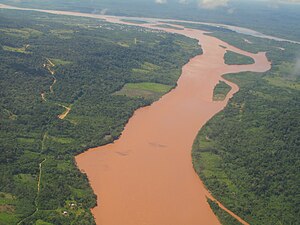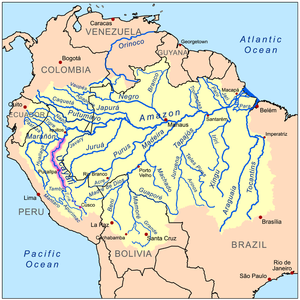This articleneeds additional citations forverification.(February 2015) |
TheUcayali River(Spanish:Río Ucayali,IPA:[ˈri.owkaˈʝali]) is the main headstream of theAmazon River.It rises about 110 km (68 mi) north ofLake Titicaca,in theArequipa regionofPeruand becomes the Amazon at the confluence of theMarañónclose toNautacity. The city ofPucallpais located on the banks of the Ucayali.
| Ucayali River | |
|---|---|
 Confluence of theTambo(from bottom) andUrubamba Rivers(background right) forming the Ucayali River (background left) | |
 Map of theAmazon Basinwith the Ucayali River highlighted | |
| Location | |
| Country | Peru |
| Physical characteristics | |
| Source | confluence of theTamboandUrubamba Rivers |
| • location | Atalaya,Ucayali,Peru |
| Mouth | Amazon River |
• location | confluence withMarañón River,Loreto,Peru |
| Length | 2,238 km (1,391 mi)[1] 1,460 km (910 mi)[2] |
| Basin size | 351,549 km2(135,734 sq mi)[1] |
| Discharge | |
| • location | Requena,Peru |
| • average | (Period of data: 1990-2006)13,385 m3/s (472,700 cu ft/s)[4]
13,500 m3/s (480,000 cu ft/s) (Confluence ofMarañón:~13,800 m3/s (490,000 cu ft/s)) |
| • minimum | 3,000 m3/s (110,000 cu ft/s)[3] |
| • maximum | 28,000 m3/s (990,000 cu ft/s)[3] |
| Discharge | |
| • location | Pucallpa,Peru(Basin size: 260,733 km2(100,670 sq mi) |
| • average | (Period of data: 1990-2006)8,931.2 m3/s (315,400 cu ft/s)[4] |
| Basin features | |
| Tributaries | |
| • left | Tambo,Pachitea,Aguaytia,Pacaya,Pisqui,Cushabatay |
| • right | Urubamba,Tamaya,Tapiche |
Description
editThe Ucayali, together with theApurímac River,theEne Riverand theTambo River,is today considered themain headwater of theAmazon River,totaling a length of 2,669.9 kilometres (1,659.0 mi) from the source of theApurímacatNevado Mismito the confluence of the Ucayali andMarañón Rivers:
- Apurímac River (total length): 730.7 km (454.0 mi)
- Ene River (total length): 180.6 km (112.2 mi)
- Tambo River (total length): 158.5 km (98.5 mi)
- Ucayali River (confluence with Tambo River to confluence with the Marañón): 1,600.1 km (994.3 mi)
Exploration
editThe Ucayali was first calledSan Miguel,thenUcayali,Ucayare,Poro,Apu-Poro,CocamaandRio de Cuzco.Peruhas organised many costly and ably-conducted expeditions to explore it. One of them (1867) claimed to have reached within 380 km (240 mi) ofLima,and the little steamer "Napo" found its way up the violent currents for 124 km (77 mi) above the junction with thePachitea River,and as far as the Tambo River, 1,240 km (770 mi) from the confluence of the Ucayali with the Amazon. The "Napo" then succeeded in ascending theUrubamba River56 km (35 mi) upstream from its junction with the Tambo, to a point 320 km (200 mi) north ofCuzco.
Navigation
editThe Ucayali's width varies from 400–1,200 metres (1,300–3,900 ft), due to the large number of islands. The current runs from 5–6 kilometres per hour (3.1–3.7 mph), and a channel from 20–50 metres (66–164 ft) wide can always be found with a minimum depth of 1.5 m (4.9 ft). There are five difficult passes, due to the accumulation of trees and rafts of timber. Sometimes large rocks which have fallen from the mountains and spread across the riverbed cause whirlpools.
National Reserve
editThe Ucayali is home to theAmazon river dolphin,giant otter,and theAmazonian manatee,which are abundant inPacaya-Samiria National Reserve,close to Nauta. The southeastern border of the reserve is formed by the lower Ucayali River.
The river gives its name to theUcayali RegionofPeruand theUcayali Provinceof the Loreto Region.
See also
editReferences
edit- ^ab"Archived copy"(PDF).Archived fromthe original(PDF)on 2021-11-13.Retrieved2023-04-06.
{{cite web}}:CS1 maint: archived copy as title (link) - ^Ziesler, R.; Ardizzone, G.D. (1979). "Amazon River System".The Inland waters of Latin America.Food and Agriculture Organization of the United Nations.ISBN92-5-000780-9.Archivedfrom the original on 8 November 2014.
- ^ab"Archived copy"(PDF).Archived fromthe original(PDF)on 2021-11-13.Retrieved2023-04-06.
{{cite web}}:CS1 maint: archived copy as title (link) - ^ab"Nuevo Repositorio Institucional"(PDF).Retrieved2023-04-06.